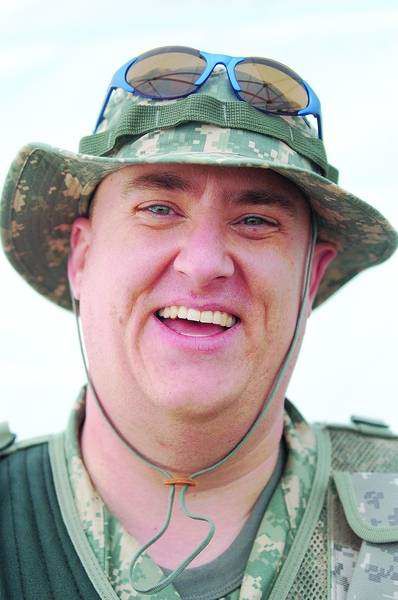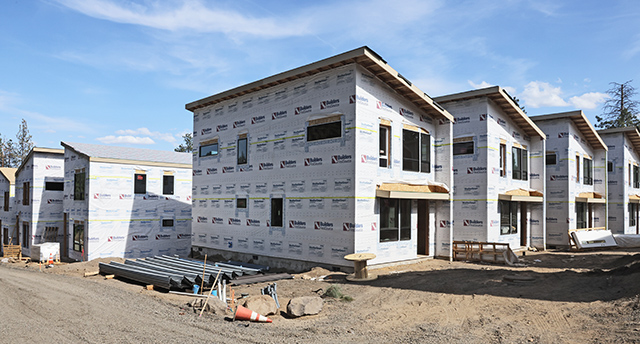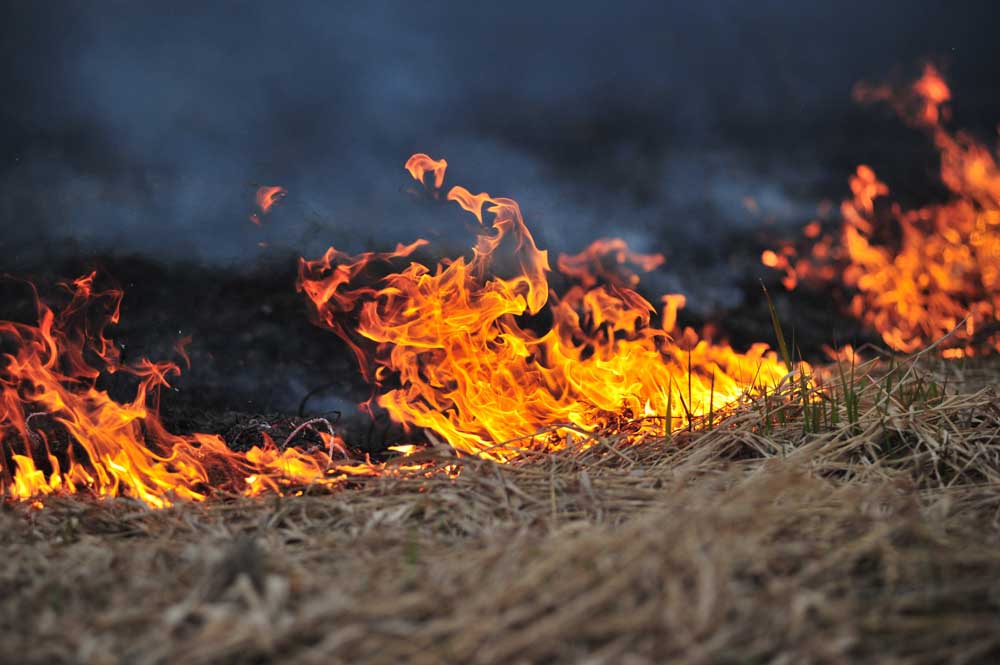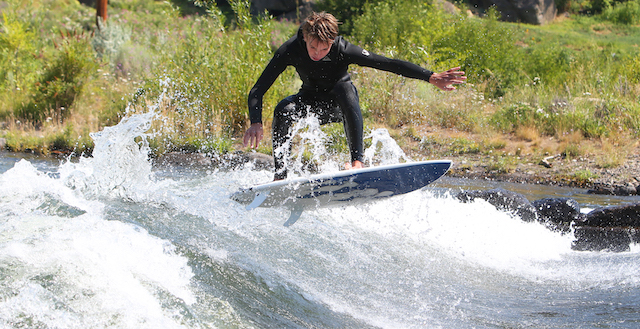Painted desert
Published 5:00 am Saturday, May 27, 2006

- Brad Hoskin, of Redmond, is an avid paintballer.
he trailer was a death trap, the players said.
An old metal-skinned camp trailer surrounded by plywood walls and defenses, the trailer was the central objective of a paintball battle Sunday that brought more than 60 camouflaged men and women to the desert east of Bend for war.
Within seconds of the air horn that sounded the beginning of their first game, one team overtook the trailer and held it against assaults from the other team, each group of fighters denoted by neon-colored arm bands. Soldiers ducked behind wood fences to take aim at the trailer while being picked off by opponents from within the structure and from other defensive positions nearby. Those trapped within the trailer were at the mercy of whatever shooter got close enough to fire into the building. Meanwhile, fighters snuck through a maze of shallow trenches, belly-crawling to get close enough to the trailer to take out an opponent without being shot. The desert was filled with the KAK-KAK-KAK-KAK of paintball guns, puffs of smoky air emerging from their barrels after every shot.
”There’s a real firefight going on over there,” said one soldier from behind his protective face mask as he left the field of battle. Two globs of neon green paint glinted on his chest, evidence that he was shot by another player. By the rules of this game, one shot to the head or two shots to the body constitutes a kill, forcing the player to leave the game until a designated ”spawning” time every quarter hour, when players who have been shot can storm the field once more.
War games
Hundreds of people in Central Oregon play paintball games, in which players shoot guns charged with compressed air or carbon dioxide, said Brad Hoskin, a longtime player and Gulf War veteran. Their ammo – marble-sized balls of dyed liquid encased in thin skins of gelatin – ruptures when it strikes an object with enough force. The dye is water-soluble and nontoxic.
While many paintball players play games on public land – forest areas or swathes of desert – a group in Central Oregon has developed six acres of scrubland east of Bend into a battlefield of epic proportions.
Ed Dorsett bought 20 acres of undeveloped desert last year. Starting in December, Dorsett and other members of his High Desert Scenario paintball club worked on developing the six acres of the property. With shovels and backhoes, they dug 1,500 feet of shallow trenches crisscrossing the property. Another 800 feet of trenches large enough for vehicles edge parts of the field. A 10-foot berm stands between the players and the staging area/parking lot.
The playing field also includes bunkers, fences, hidy-holes and bits of pallet erected randomly to provide cover for players during battle. Every structure on the field is covered with a patina of paint splatters. The trailer – the main objective of many a battle – sits in the middle of the field. An old satellite dish nearby is also often a target during games.
Dorsett’s field is especially important to the local paintball community now that another oft-used paintball field is closed to play. The former dicalite mine near Crooked River Ranch – affectionately dubbed the Kitty Litter Factory by paintballers – closed to paintballers in March after years of being used as a paintball war zone.
For the members of High Desert Scenario, paintball isn’t just a game of target practice or goofing off, so having a playing field with bunkers, trenches and other features is important. During their games, the players act out detailed battles in the style of military simulation.
”The mil-sim stuff attracts a lot of guys – you know, the hunt, the kill,” Dorsett said. ”Boys will be boys, and they like to be G.I. Joe.”
If G.I. Joe were a contemporary soldier decked out in state-of-the-art battle gear.
The paintballers playing Sunday wore all manner of camouflage garb, most of it in hues of dun and brown to blend with the desert terrain. One player even sported a ghillie suit, made to blur the outlines of the wearer with a nest of fibers and twigs surrounding the body.
Full-face masks (required at all times on the field) left only players’ eyes visible behind plastic shields. Most players wore tactical vests with multiple pockets for small canisters of paintballs. Although the hoppers mounted atop the paintball guns hold several hundred rounds, shooters need to reload multiple times during an hourlong game. Many players used remote air canisters to power their guns; remote canisters allow more maneuverability because the air is fed to the gun by a hose instead of through a canister mounted on top of the gun. It can cost close to $1,000 to outfit a player for military simulation-style paintball, said player Dave Arata. Joining High Desert Scenario costs $30 per year.
Battle-ready
The rain had just let up Sunday when the paintball players gathered at Dorsett’s field began tightening their bootlaces, checking their guns and adjusting their face masks. Dorsett rounded up the group under a threatening sky for a prewar briefing. The objective: for each team to take and hold the main bunkers on the field. The team holding two of the three bunkers at game’s end won. The rules: Call yourself out if there’s no chance of moving from position without being riddled with paintballs; referees on the field would make rulings; don’t shoot ”dead men” leaving the field.
With about 30 players on each team, the field was crawling with players as they took off from starting points at the game’s beginning. The teams divided into smaller squads with specific agendas, such as sneaking close to a particular bunker or flanking another group of players to take them out.
”You’re on your own buddy,” called one player to his teammate after he was shot. ”You got a guy to your left, right to your left!” he warned as he left their field.
Those who had been shot would hold their hands up and walk off the field. Those who remained crawled through the brush and trenches, darted between bits of cover and used columns of orange smoke to screen their movements.
The rain began again midway though the hourlong game. Its accompanying wind tossed paintballs off course, but did nothing to deter the paintball warriors from their operation. Paintballs whirred through the air, slow enough to be seen coming toward you and fast enough to hurt when they got there. Before the game, Dorset flashed his wrist to the other players, showing where a paintball left a bloody red welt the night before, catching him just above the glove during a protracted night game.
”It’ll leave a bruise, it’s that simple,” he said.
Hoskin, who’s been playing paintball for 15 years, agreed. Paintballs can travel 300 feet per second, the maximum velocity allowed during a game, he said. Each gun is tested before a game to make sure it can’t fire faster than that, but 300 feet per second still stings.
Pain aside, paintball is a hobby participants embrace with edgy enthusiasm.
”It’s just such a blast,” said Sarah Grimes, 24, Bend. ”The thrill, and your adrenaline starts pumping …”. Grimes said paintball is something she and her husband, Matthew, can do together.
Many in the paintball group have been playing together for years.
”We have a really great local paintball community,” said Joe Hite, who helped organize Sunday’s games. The community includes clubs and teams like the Sage Rats, Operators and the Hellfish, all of whom play ”woodsball,” or scenario-based, all-terrain paintball in more-or-less natural settings. Other groups, such as the Evil Spartans, play ”speedball,” a faster-paced paintball that uses inflatable obstacles and is often seen on ESPN.
Dorsett supports them all, sponsoring many teams through his business, D’s Hobbies. All are part of the High Desert Scenario games on Dorsett’s field, which take place at least monthly.
”Ed takes care of us,” said Hite as he eyed the group of paintballers waiting to take to the field.
Suited up and ready to play, the paintball players look like nothing so much as a tactical assault group storming a remote training facility in Afghanistan. Yet, even after an hour or two of shooting at each other, they share a laugh and a campfire, recounting the battle with smiles.
”All this is, is an extension of tag,” said Hoskin.






